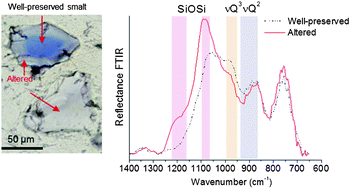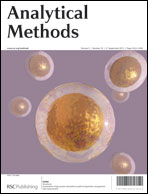The blue pigment smalt, a potash silicate glass coloured with cobalt, was commonly used between the sixteenth and eighteenth centuries. The composition is complex and can vary considerably depending on the manufacturing process and the elements that are present in the raw materials in addition to the essential silica, potassium and cobalt. It also often degrades through leaching of potassium, leading to a change in cobalt coordination from tetrahedral to octahedral, and a loss of the blue colour. In this study smalt pigment (both well preserved and altered) in samples from paintings in French collections (mainly Musée du Louvre) and in the National Gallery, London, as well as modern references of more simple composition, was analysed by the complementary vibrational techniques Raman micro-spectroscopy and synchrotron Fourier transform infrared micro-spectroscopy. Comparison of the spectra with those from modern smalt, together with spectral decomposition and correlation with quantitative SEM-EDX elemental analysis, sheds new light on the role of the various cations in the silicate structure. Important modifications in the structure of the pigment on alteration are also revealed, in particular leaching of alkali and the formation of silanols, which subsequently condense to create new bridging Si–O–Si bonds and molecular water in the glass. The sensitivity of the glass to dry conditions creates a tendency towards shrinking and cracking, which is very likely a contributing factor in the loss of cohesion, breakdown and blanching often observed in paint containing degraded smalt.

You have access to this article
 Please wait while we load your content...
Something went wrong. Try again?
Please wait while we load your content...
Something went wrong. Try again?


 Please wait while we load your content...
Please wait while we load your content...